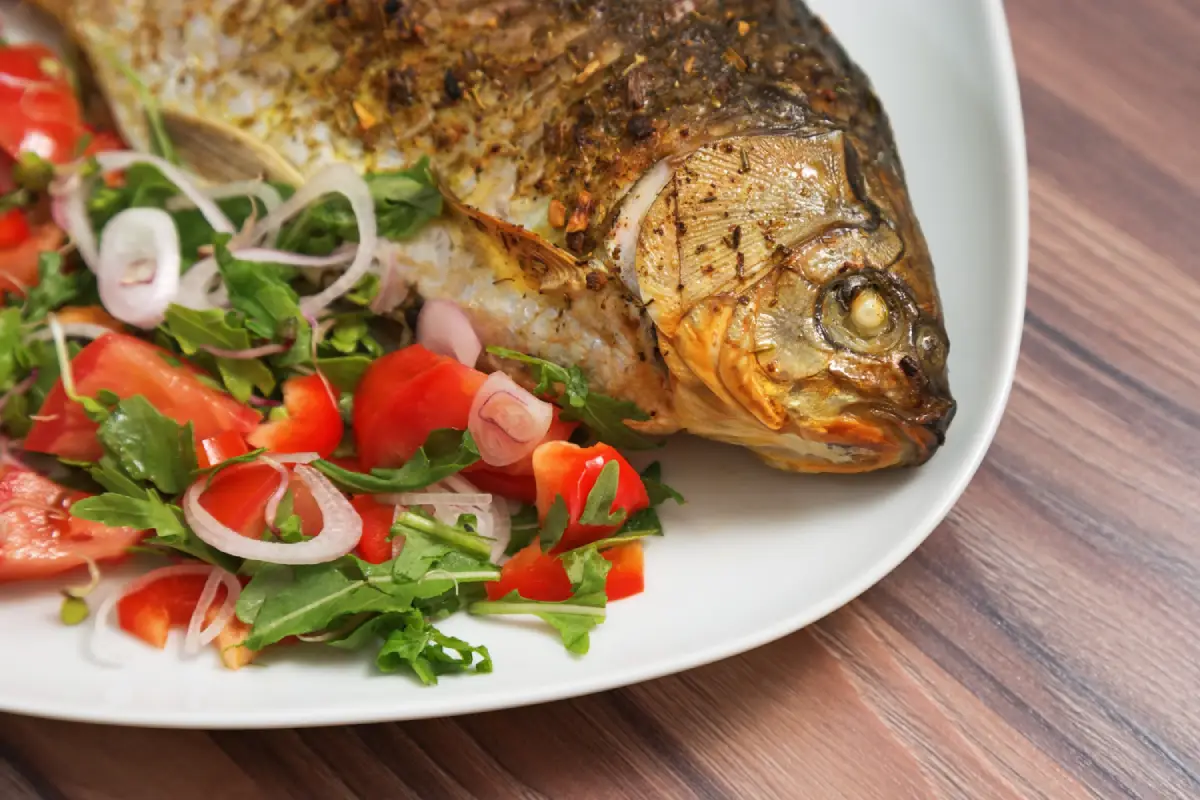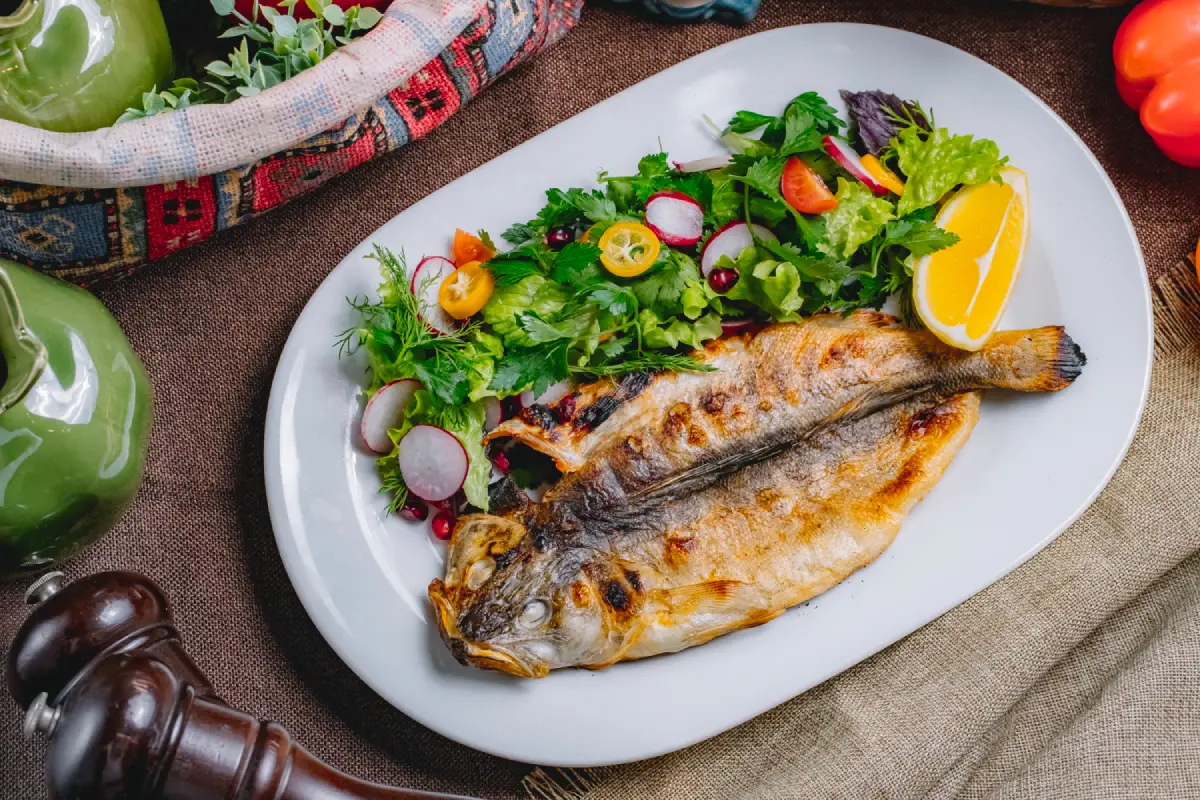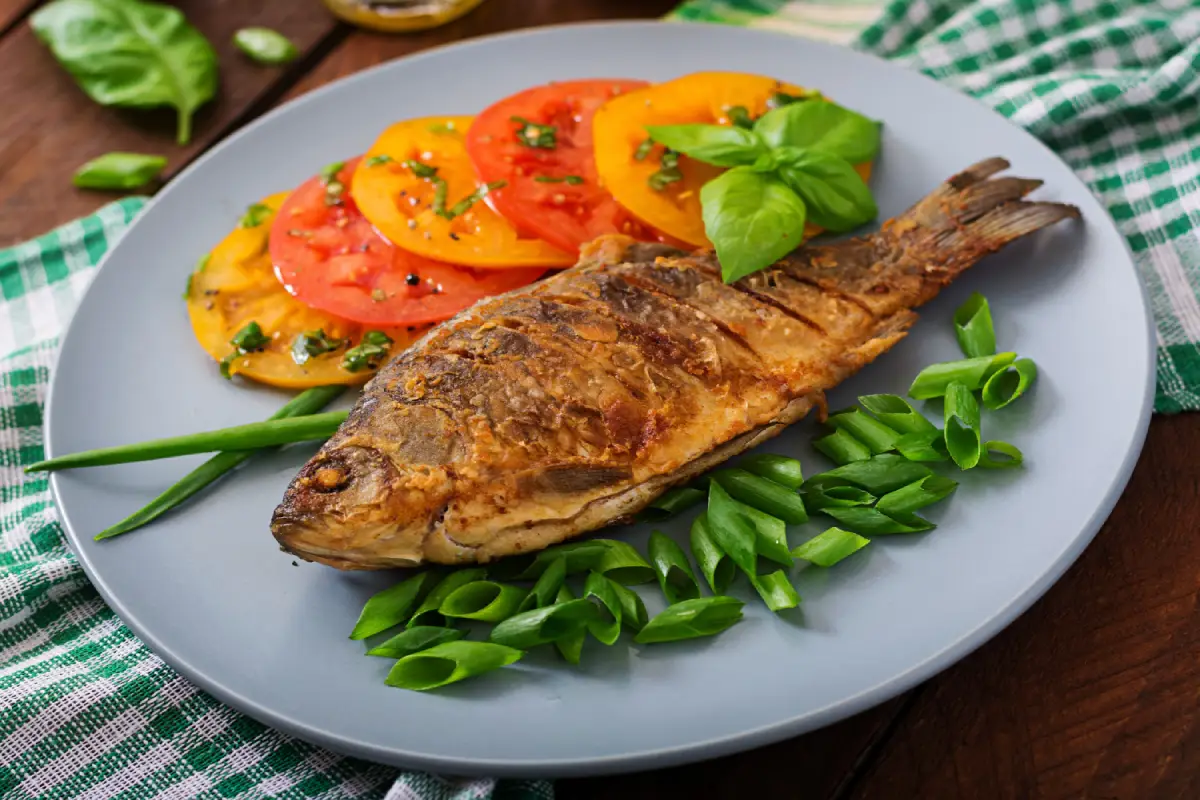Welcome to a culinary journey that marries simplicity with elegance on your plate. Today, we’re diving into a Healthy Roasted Fish with Seasonal Vegetables and Lemon Recipe that’s more than just a meal—it’s a feast for the senses. Perfect for anyone looking to impress, from cozy family gatherings to special occasions, this dish combines the richness of the ocean with the earth’s freshest bounty. Embark with us as we explore not only a mouthwatering recipe but also the secrets to choosing the best ingredients, mastering the perfect roast, and presenting a dish that’s as beautiful to look at as it is delicious to eat. Ready your kitchens; a delightful culinary experience awaits.
The Art of Roasting Fish

Roasting fish is a culinary technique that, when done right, yields a dish brimming with tender, juicy flavors and a beautiful, crisp exterior. The secret to a perfectly roasted fish lies in understanding the nuances of this cooking method. Here are key tips to ensure your roasted fish is nothing short of spectacular:
Preheat Your Oven
The perfect roast starts with the right temperature. Preheat your oven to 400°F (200°C), a sweet spot for most fish types, ensuring a crispy outside while keeping the inside moist and tender.
Choose the Right Fish
Not all fish are created equal when it comes to roasting. Look for firm, fatty fish like salmon, sea bass, or cod. These varieties not only withstand the heat of the oven better but also retain their moisture and flavor.
Prepare the Fish
Pat your fish dry with paper towels before seasoning. This step is crucial for achieving that desirable crispy skin. Lightly coat the fish with olive oil, then season generously with salt, pepper, and any other spices or herbs you prefer.
Use a Roasting Rack
Placing your fish on a roasting rack over a baking sheet allows air to circulate around the fish, cooking it evenly and helping the skin become crisp. If you don’t have a roasting rack, a parchment-lined baking sheet is a good alternative.
Don’t Overcrowd
Give your fish some breathing room on the pan. Crowding can lead to steaming instead of roasting, robbing you of that crisp texture.
Cooking Time
Cooking time depends on the thickness of your fish. A good rule of thumb is to roast for 10 minutes per inch of thickness. Use a meat thermometer to ensure the fish reaches an internal temperature of 145°F (63°C) for optimal doneness.
Let It Rest
Resist the urge to dive right in. Letting the fish rest for a few minutes after taking it out of the oven allows the juices to redistribute, ensuring every bite is moist and flavorful.
By mastering these steps, you’ll transform a simple piece of fish into a delectable masterpiece, ready to be paired with fresh vegetables and a squeeze of lemon for that perfect finish. Next, we’ll explore how to select the right fish for roasting, ensuring your dish is a cut above the rest.
Choosing the Right Fish
The selection of fish is a pivotal step in crafting a dish that stands out, both in flavor and texture. Here’s how to ensure you pick the perfect protagonist for your roasted fish recipe:
Freshness is Key
Fresh fish is the cornerstone of any great seafood dish. Look for bright, clear eyes and firm, shiny flesh. The fish should smell of the ocean, not fishy. If buying whole fish, the gills should be bright red or pink.
Consider the Source
Sustainability matters. Opt for fish sourced from environmentally responsible fisheries. This not only supports eco-friendly practices but often guarantees a higher quality of fish. Check labels or ask your fishmonger about the origin.
Fatty vs. Lean Fish
Fatty fish like salmon, trout, and mackerel are ideal for roasting as their natural oils keep them moist and flavorful throughout the cooking process. Leaner fish like cod, snapper, or sea bass, while also great options, may require extra care (such as a protective oil coating) to prevent drying out.
Skin-on or Skin-off?
For roasting, skin-on fillets are preferable. The skin acts as a protective layer, keeping the flesh moist. It also provides a crispy texture that’s highly sought after in roasted fish dishes. If you’re not a fan of eating skin, it can easily be removed after cooking.
Size Matters
Consider the size of the fish or fillets when planning your meal. Individual fillets or smaller fish are ideal for single servings, while a larger fish can be a dramatic centerpiece that allows guests to serve themselves.
Tailor to Your Taste
While some recipes may call for specific types of fish, don’t be afraid to experiment with what’s available and what suits your taste preferences. The beauty of roasting fish is its versatility, so feel free to explore different options.
Armed with these tips, you’re ready to select the best fish for roasting. Next, we’ll delve into the world of fresh vegetables, guiding you through the best pairings to complement your beautifully roasted fish, enhancing the overall harmony of flavors on your plate.
Fresh Vegetables Pairing
Pairing the right vegetables with your roasted fish can transform a simple dish into a colorful, nutritious, and complete meal. The choice of vegetables not only adds visual appeal but also complements and contrasts the flavors and textures of the fish. Here’s how to select and prepare vegetables that will elevate your dish:
Seasonal Selections
Opting for seasonal vegetables guarantees freshness, better flavor, and nutritional content. Spring offers asparagus and green beans, summer brings bell peppers and zucchini, autumn welcomes squashes and root vegetables, while winter provides hearty options like kale and Brussels sprouts.
Texture and Flavor Contrast
Pairing your fish with a variety of textures and flavors can enhance the overall dining experience. Consider a mix of crunchy, soft, sweet, and bitter vegetables to create a balanced plate. For instance, the natural sweetness of roasted carrots or beets can complement the savory notes of the fish.
Preparation Matters
How you prepare your vegetables can greatly affect their texture and flavor. Roasting vegetables alongside the fish can infuse them with its flavors, creating a cohesive dish. Alternatively, steaming or blanching preserves their natural crispness and color, offering a fresh contrast to the rich, roasted fish.
Quick Picks
- For light, white fish (e.g., cod, tilapia): Pair with delicate vegetables like spinach, zucchini, or cherry tomatoes.
- For oily, rich fish (e.g., salmon, mackerel): Opt for robust, earthy vegetables like Brussels sprouts, asparagus, or sweet potatoes.
Adding a Splash of Color
Don’t underestimate the power of color; vibrant vegetables not only make the dish more visually appealing but also indicate a variety of nutrients. Incorporate a rainbow of vegetables like red peppers, yellow squash, green asparagus, and purple onions.
Dressing and Seasoning
A simple dressing or seasoning can tie the vegetables and fish together. A drizzle of olive oil, lemon juice, and a sprinkle of herbs like dill or parsley can elevate the natural flavors of both the fish and vegetables.
Cooking Times
Consider the cooking times of different vegetables to ensure everything is perfectly cooked. Some vegetables, like potatoes, take longer and might need a head start, while tender greens like spinach require just a few minutes.
By thoughtfully selecting and preparing vegetables to accompany your roasted fish, you create a meal that’s not only delicious but also a feast for the eyes. With these tips, your dish will be a harmonious blend of flavors and textures, perfect for any occasion.
Next, we’ll explore the zesty world of lemons and how this citrus wonder can add a burst of freshness and elevate your roasted fish and vegetables to new heights.
Enhancing with Lemon

Lemon plays a pivotal role in elevating the flavors of roasted fish and fresh vegetables, acting as a bridge that ties the components of your dish together with its vibrant zest and acidity. Here’s how to make the most of this citrus wonder:
The Brightness of Lemon Juice
A squeeze of fresh lemon juice over your roasted fish right before serving can transform the dish, cutting through the richness and highlighting its delicate flavors. Similarly, a dash over vegetables can enhance their natural taste, making them more vibrant and refreshing.
Zest for Added Aroma
Lemon zest contains essential oils that add an incredible burst of flavor and aroma. Sprinkling finely grated zest over your dish or incorporating it into marinades or dressings infuses your meal with a subtle, yet complex citrus note that’s hard to replicate with any other ingredient.
Lemon as a Marinade
Marinating your fish in a mixture of lemon juice, olive oil, and herbs not only imparts flavor but also tenderizes the fish, ensuring it stays moist and flavorful during roasting. Remember, due to its acidic nature, lemon juice can start “cooking” the fish if left marinating for too long, so a short marination period is optimal.
Decorative and Functional
Thinly sliced or wedged, lemon can also serve as a decorative element on your plate, inviting diners to adjust acidity to their taste. Additionally, placing lemon slices beneath fish fillets while roasting can prevent sticking and infuse the fish with a gentle lemony steam.
Pairing with Herbs
Lemon’s affinity with herbs like dill, parsley, and thyme can be leveraged to create harmonious blends that work beautifully with both the roasted fish and vegetables. Whether used in dressings, as garnishes, or incorporated into dishes, these combinations offer a fresh, garden-like quality that elevates the entire meal.
Lemon-Infused Oils and Butters
For an understated yet impactful touch, consider drizzling lemon-infused olive oil over your finished dish, or melting a dollop of lemon herb butter on top of the fish as it comes out of the oven. These condiments add a luxurious feel and depth of flavor that makes the dish restaurant-quality.
Incorporating lemon in these various ways not only adds layers of flavor but also introduces an element of freshness that balances the richness of the roasted fish and earthiness of the vegetables. Next, we’ll dive into the world of herbs and spices, revealing how they can elevate your roasted fish dish from good to gourmet.
Herbs and Spices to Elevate Your Dish
The right selection of herbs and spices can transform your roasted fish and vegetable dish into a culinary masterpiece. These aromatic additions infuse your meal with depth, complexity, and a burst of vibrant flavor. Here’s how to choose and use them to their full potential:
Understanding Flavor Profiles
Each herb and spice comes with its unique flavor profile that can complement or enhance the natural tastes of your fish and vegetables. Delicate herbs like dill, parsley, and chervil are perfect for lighter fish varieties, adding a fresh, grassy note. Robust herbs such as rosemary, thyme, and oregano pair well with fattier fish, offering a hearty, earthy flavor.
Spice it Up
Spices can add warmth and dimension to your dish. A pinch of paprika or cayenne pepper introduces a subtle heat that contrasts nicely with the freshness of the vegetables and the richness of the fish. Ground coriander or cumin can offer an earthy, citrusy note that complements both the fish and the veggies.
Making Marinades and Rubs
Creating a marinade or rub with your chosen herbs and spices is an excellent way to infuse the fish with extra flavor. Olive oil, lemon juice, minced garlic, and your selected herbs and spices mixed together can create a flavorful coating that penetrates the fish, ensuring every bite is delicious.
Garnishing with Freshness
Garnishing your finished dish with fresh herbs not only adds a pop of color but also injects a burst of flavor that complements the roasted textures and tastes. Sprinkle freshly chopped herbs over your plated dish for an aromatic finish.
Balancing Flavors
When selecting herbs and spices, aim for a balance that complements the natural flavors of your fish and vegetables without overwhelming them. Consider the overall flavor profile of your dish and select seasonings that will harmonize with, not dominate, the main ingredients.
Experiment and Taste
Don’t be afraid to experiment with different herb and spice combinations. Cooking is as much about creativity as it is about technique. Start with small amounts, taste as you go, and adjust according to your preferences and the specific flavors of your ingredients.
With these guidelines, you can confidently use herbs and spices to enhance the natural beauty and flavor of your roasted fish and vegetables. Up next, we’ll delve into the health benefits of this dish, highlighting why it’s not just a feast for the senses but also a boon for your well-being.
The Health Benefits of Roasted Fish and Vegetables
Elevating your dining experience with a delicious roasted fish and fresh vegetables dish not only pleases the palate but also offers numerous health benefits. This meal is a powerhouse of nutrients, making it an excellent choice for those seeking to maintain a healthy lifestyle without sacrificing flavor. Here’s why this dish is as good for you as it is gourmet:
Rich in Omega-3 Fatty Acids
Many fish varieties, especially fatty fish like salmon, mackerel, and trout, are rich sources of omega-3 fatty acids. These essential nutrients are crucial for heart health, aiding in lowering blood pressure, reducing triglycerides, and decreasing the risk of heart disease.
High in Protein
Fish is an excellent source of high-quality protein, essential for building and repairing tissues in the body. It’s also typically lower in saturated fat than some meat alternatives, making it a leaner choice for those looking to increase their protein intake.
Loaded with Vitamins and Minerals
Both fish and vegetables are packed with vitamins and minerals. Fish is a great source of vitamin D and B2 (riboflavin), as well as minerals like zinc, iron, iodine, magnesium, and potassium. Vegetables, depending on their variety, can provide vitamins A, C, K, and E, along with antioxidants that help protect the body against free radicals.
Promotes Healthy Digestion
The fiber content in vegetables is beneficial for the digestive system, helping to maintain bowel health and prevent constipation. A diet rich in fiber can also help to keep you feeling full longer, aiding in weight management.
Lowers the Risk of Chronic Diseases
Eating a diet high in fish and vegetables has been linked to a lower risk of chronic diseases such as obesity, type 2 diabetes, and certain types of cancer. The nutrients found in this meal support a healthy immune system and help to reduce inflammation in the body.
Supports Brain Health
Omega-3 fatty acids are not only good for the heart but also the brain. Regular consumption can contribute to improved brain function, with potential benefits in reducing the risk of cognitive decline and depression.
Easy to Digest
Compared to heavier, fattier meats, fish is easier to digest, making it a comfortable meal option that won’t leave you feeling overly full or sluggish. Paired with the natural lightness of fresh vegetables, it’s the perfect meal for maintaining energy and satiety.
By incorporating roasted fish and fresh vegetables into your diet, you’re not just treating yourself to a delicious meal; you’re also taking a step towards a healthier, more balanced lifestyle. Next, we’ll share tips on how to beautifully plate your dish, turning each meal into a visually stunning experience that delights all the senses.

Mastering the art of roasting fish and pairing it with fresh, seasonal vegetables is a culinary adventure that rewards with every bite. This dish, bursting with flavors and teeming with health benefits, is a testament to the beauty of simple, nourishing ingredients coming together on a plate. Whether you’re seeking to impress guests, treat your family, or indulge in a personal gourmet experience, this recipe stands as a beacon of healthy, delicious dining.
But the journey doesn’t have to end here. Explore the vast horizons of culinary delights with our specially curated guides, each designed to elevate your home cooking experience:
- A Guide to Homemade Falafel, Hummus, and Pita: Dive into the heart of Middle Eastern cuisine with this comprehensive guide. Perfect for vegetarians or anyone looking to spice up their meal repertoire.
- Lentil Cream Soup Recipe Guide: Warm up with a bowl of comforting lentil cream soup. This recipe is a hug in a bowl, ideal for chilly evenings or as a starter to your gourmet meals.
- Crispy Fried Chicken Guide: Indulge in the ultimate comfort food with a crispy, juicy fried chicken recipe that promises to be a crowd-pleaser at any gathering.
Read Also: Grilled Chicken Breast Vegetables: A Healthy and Flavorful Guide

